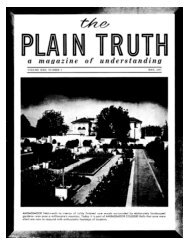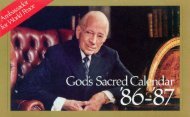The Biblical Basis of the Sacred Calendar Part One
The Biblical Basis of the Sacred Calendar Part One
The Biblical Basis of the Sacred Calendar Part One
You also want an ePaper? Increase the reach of your titles
YUMPU automatically turns print PDFs into web optimized ePapers that Google loves.
example <strong>of</strong> a "day <strong>of</strong> preparation" before <strong>the</strong> weekly Sabbath, this reasoning makes a certain amount <strong>of</strong><br />
sense (cf. Exodus 16:23) .38<br />
But Rule 1 specifically affects four Holy Days in a row: Trumpets, Atonement, <strong>the</strong> first day <strong>of</strong> Tabernacles,<br />
and <strong>the</strong> Last Great Day. If Trumpets could fall on a Sunday, Wednesday or Friday, <strong>the</strong>n three, one or all<br />
four fall Holy Days could occur back-to-back with <strong>the</strong> weekly Sabbath.39 Under Rule 1, none <strong>of</strong> <strong>the</strong>se<br />
days can fall before or after <strong>the</strong> Sabbath. But despite Rule 1, <strong>the</strong> Passover and all <strong>of</strong> <strong>the</strong> spring Holy Days<br />
can and do occur (in <strong>the</strong> case <strong>of</strong> <strong>the</strong> true Pentecost, every year) back-to-back with <strong>the</strong> weekly Sabbath.<br />
<strong>The</strong> fall Holy Days (in contrast to <strong>the</strong> spring Holy Days) are called High Holy Days by Rabbinic Judaism.<br />
(Do not confuse this Jewish usage with <strong>the</strong> description <strong>of</strong> Abib/Nisan 15 as a "high day" in John 19:31.)<br />
When we examine <strong>the</strong> Scriptures, we see that <strong>the</strong>re is in fact a hierarchy <strong>of</strong> holiness in <strong>the</strong> Festivals:<br />
Atonement, <strong>the</strong> weekly Sabbath, <strong>the</strong> o<strong>the</strong>r fall Holy Days, and <strong>the</strong> spring Holy Days, in that order.<br />
First, what do <strong>the</strong> fall Holy Days have in common which sets <strong>the</strong>m apart from <strong>the</strong> spring Holy Days?<br />
* <strong>The</strong>y occur within <strong>the</strong> space <strong>of</strong> one month (and in <strong>the</strong> fall).<br />
* Each is called a shabbaton ("sabbatism", "complete rest", etc.), a term which is also applied<br />
to <strong>the</strong> weekly Sabbath (but not to <strong>the</strong> spring Holy Days).40<br />
* Three <strong>of</strong> <strong>the</strong>m are separate, one-day Festivals (<strong>the</strong> o<strong>the</strong>r being <strong>the</strong> sole Holy Day out <strong>of</strong><br />
seven Festival days). This makes <strong>the</strong> meaning <strong>of</strong> each day stand out more readily than<br />
o<strong>the</strong>rwise. Among <strong>the</strong> spring Holy Days, only Pentecost is a one-day Festival (and is related<br />
by a count <strong>of</strong> days to Unleavened Bread as well).<br />
* <strong>The</strong>y are associated (even in Rabbinic Judaism) with God's future judgment <strong>of</strong> <strong>the</strong> world.41<br />
What do Atonement and <strong>the</strong> weekly Sabbath have in common?<br />
* <strong>The</strong>y are both specifically called shabbat shabbaton, "a sabbath <strong>of</strong> complete rest"<br />
(Leviticus 23:3, 32). This is true <strong>of</strong> none <strong>of</strong> <strong>the</strong> o<strong>the</strong>r Holy Days. (In particular, <strong>the</strong> o<strong>the</strong>r Fall<br />
Holy Days are simply called shabbaton, not shabbat shabbaton.)<br />
* No work <strong>of</strong> any kind is permitted on <strong>the</strong>se days (same verses). On <strong>the</strong> o<strong>the</strong>r Holy Days, no<br />
servile work is permitted. (<strong>The</strong> prohibition against "work" on <strong>the</strong> last Day <strong>of</strong> Unleavened<br />
Bread, found in Deuteronomy 16:8, does not specify ei<strong>the</strong>r "any work" or "servile work". It is<br />
simply a general prohibition.)<br />
* Under <strong>the</strong> Old Covenant, he who worked on ei<strong>the</strong>r <strong>of</strong> <strong>the</strong>se days was to be "cut <strong>of</strong>f from<br />
among his people" (Leviticus 23:30; Exodus 31:14). Once again, this is not stated about <strong>the</strong><br />
o<strong>the</strong>r Holy Days.<br />
Thus, while all Holy Days are "sabbaths" (compare John 19:31), not every Holy Day is called shabbaton,<br />
let alone shabbat shabbaton. Atonement has <strong>the</strong> greatest restriction on "work"; <strong>the</strong>n, <strong>the</strong> weekly Sabbath;<br />
<strong>the</strong>n, <strong>the</strong> fall Holy Days; <strong>the</strong>n, <strong>the</strong> spring Holy Days.42 Note how <strong>the</strong> terminology and <strong>the</strong> restrictions on<br />
"work" correlate: Atonement is called shabbat shabbaton (and enjoins fasting besides). <strong>The</strong> weekly<br />
Sabbath (on which one may eat but not cook food: Exodus 16:23) is likewise called shabbat shabbaton.<br />
<strong>The</strong> o<strong>the</strong>r fall Holy Days (which are special "feast days" <strong>of</strong> eating and drinking) are called simply<br />
shabbaton; and <strong>the</strong> spring Holy Days (notably <strong>the</strong> first Day <strong>of</strong> Unleavened Bread,43 on which we are<br />
specifically told food may be prepared: Exodus 12:16) are called by none <strong>of</strong> <strong>the</strong>se terms.44<br />
This correlation is what defines <strong>the</strong> "hierarchy <strong>of</strong> holiness" mentioned above - and it leads us to <strong>the</strong> real
















